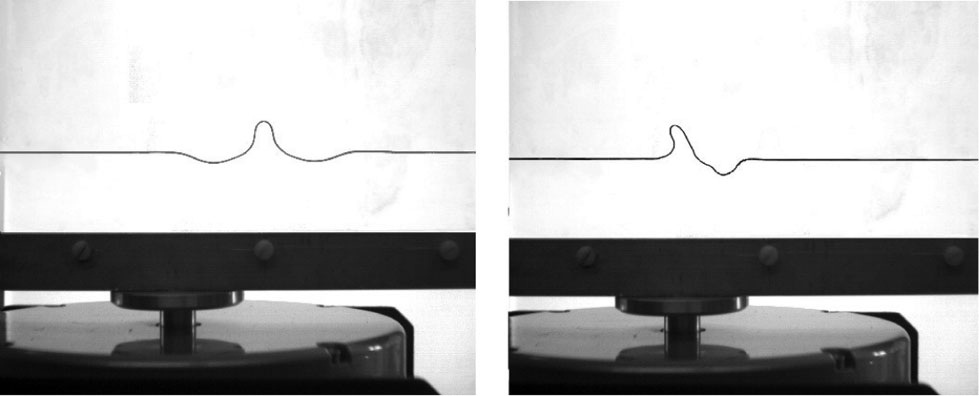
In their study, which is published in a recent issue of Physical Review Letters, the scientists explain how they discovered the new waves. They confined water inside a Hele-Shaw cell, which is a container made of two parallel glass plates separated by a small gap. In this case, the plates were positioned vertically, like the two sides of an ant farm. The plates were 30 cm wide, and the gap between them was just 1.5 mm. The water inside was about 5 cm deep.
The researchers mounted the Hele-Shaw cell on a shaker, which vertically vibrated the cell and the water inside. While carefully controlling the vibration frequency and amplitude, they recorded the water surface deformation with a high-speed camera.
When the researchers slowly increased the oscillation amplitude, two-dimensional standing waves with large amplitudes began to form on the water's surface. As the researchers explained, these waves are called Faraday waves, which form on the surface of a vibrating fluid when the vibration frequency exceeds a certain value, and the surface becomes unstable.
The researchers observed two different shapes of Faraday waves, one having even symmetry and the other having odd symmetry. The even symmetry can be seen as a vertical "mirror" symmetry between the wave's left and right sides. The odd symmetry of the second wave is only approximate, since the wave's lower half is not exactly the same shape as the upper half. Because the researchers used an external probe to briefly perturb the surface, they think that the different wave patterns are likely attributed to the probe motion.
When analyzing the standing waves, the researchers found that the two-dimensional even wave resembles the profile of a three-dimensional "axisymmetric oscillon," a type of wave that has previously been observed at the surface of a layer of vibrating bronze beads. To the researchers' knowledge, the odd standing wave has never been observed in any fluid media.
"These waves are both strongly localized, and stationary," Rajchenbach told PhysOrg.com. "Until now, two main classes of water solitary waves had been described: propagative solitons (the famous 'Korteweg de Vries') and envelope solitons (described by the nonlinear Schrodinger Equation), consisting of a large wave packet enveloping a large number of arches of 'carrier' waves. The observed waves belong to a different category of solitary waves."
When trying to understand how surface instabilities could have caused these waves to form, the researchers encountered some problems due to the waves' large amplitudes, since general amplitude equations describe waves with significantly smaller amplitudes. But in general, the researchers think that the novel wave patterns likely arise from the overlap of flat and wavy regions, both of which result from shaking-induced instabilities. The instabilities may involve mechanisms that also play a role in other fields, such as nonlinear optics, chemistry, and biology, as well as in sea waves.
"The main interest of our work obviously applies to sea nonlinear waves, and strengthens our knowledge concerning the formation of ocean waves of large amplitudes (giant 'rogue' waves or 'tsunamis')," Rajchenbach said.
More Information:
Jean Rajchenbach, et al. "New Standing Solitary Waves in Water." Physical Review Letters 107, 024502 (2011). DOI: 10.1103/PhysRevLett.107.024502



Reader Comments
to our Newsletter